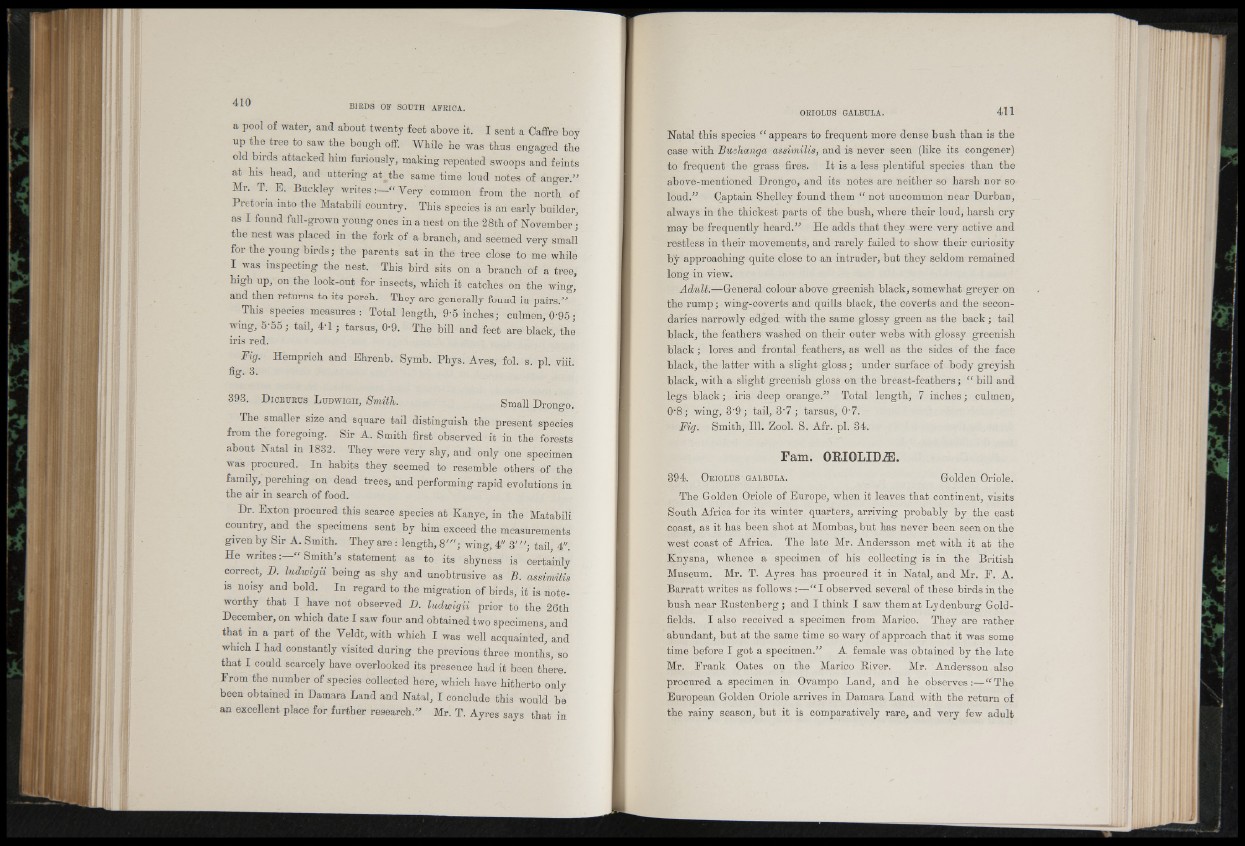
a pool of water, and about twenty feet above it. I sent a Caffre boy
up the tree to saw the bough off. While he was thus engaged the
old birds attacked him furiously, making repeated swoops and feints
at his head, and uttering at^the same time loud notes of anger.»
Mr. T. E. Buckley writes Very common from the north of
Pretoria into the Matabili country. This species is an early builder,
as I found full-grown young ones in a nest on the 28th of November ;
the nest was placed in the fork of a branch, and seemed very small
for the young birds; the parents sat in the tree close to me while
I was inspecting the nest. This bird sits on a branch of a tree,
high up, on the look-out for insects, which it catches on the wing,
and then returns to its perch. They are generally found in pairs.» Î
This species measures: Total length, 9-5 inches/ culmen, 095 ;
wing, 5-55 ; tail, 4'1 ; tarsus, 0-9. The bill and feet are black, thé
iris red.
Fig. Hemprich and Ehrenb. Symb. Phys. Aves, fol. s. pi viii
f i g . 3 .
393. D i c r u r u s L u d w i g i i , Smith. Small Drongo.
The smaller size and square tail distinguish the present species
from the foregoing. Sir A. Smith first observed it in the forests
about Natal in 1832. They were very shy, and only one specimen
was procured. In habits they seemed to resemble others of the
family, perching on dead trees, and performing rapid evolutions in
the air in search of food.
Dr. Exton procured this scarce species at Kanye, in the Matabili
country, and the specimens sent by him exceed the measurements
given by Sir A. Smith. They are : length, 8'»; wing, 4" 3 'n tail, 4".
He writes : “ Smith's statement as to its shyness is certainly
correct, D. ludwigii being as shy and unobtrusive as B. assimilis
is noisy and bold. In regard to the migration of birds, it is noteworthy
that I have not observed D. ludwigii prior to the 26th
December, on which date I saw four and obtained two specimens, and
that in a part of the Veldt, with which I was well acquainted, and
which I had constantly visited during the previous three months, so
that I could scarcely have overlooked its presence had it been there.
From the number of species collected here, which have hitherto only
been obtained in Damara Land and Natal, I conclude this would be
an excellent place for further research.” Mr. T. Ayres says that in
Natal this species “ appears to frequent more dense bush than is the
case with Buchanga assimilis, and is never seen (like its congener)
to frequent the grass fires. It is a less plentiful species than the
above-mentioned Drongo, and its notes are neither so harsh nor so
loud.” Captain Shelley found them “ not uncommon near Durban,
always in the thickest parts of the bush, where their loud, harsh cry
may be frequently heard.” He adds that they were very active and
restless in their movements, and rarely failed to show their curiosity
by approaching quite close to an intruder, but they seldom remained
long in view.
Adult.—General colour above greenish black, somewhat greyer on
the rump; wing-coverts and quills black, the coverts and the secondaries
narrowly edged with the same glossy green as the back; tail
black, the feathers washed on their outer webs with glossy greenish
black; lores and frontal feathers, as well as the sides of the face
black, the latter with a slight gloss; under surface of body greyish
black, with a slight greenish gloss on the breast-feathers; “ bill and
legs black; iris deep orange.” Total length, 7 inches; culmen,
0‘8; wing, 3'9; tail, 3‘7 ; tarsus, 0’7.
Fig. Smith, 111. Zool. S. Afr. pi. 34.
Fam. 0 RI0 LID2E.
394. O r io l u s ' g a l b u l a . Golden Oriole.
The Golden Oriole of Europe, when it leaves that continent, visits
South Africa for its winter quarters, arriving probably by the east
coast, as it has been shot at Mombas, but has never been seen on the
west coast of Africa. The late Mr. Andersson met with it at the
Knysna, whence a specimen of his collecting is in the British
Museum. Mr. T. Ayres has procured it in Natal, and Mr. F. A.
Barratt writes as follows :—“ I observed several of these birds in the
bush near Rustenberg; and I think I saw them at Lydenburg Gold-
fields. I also received a specimen from Marico. They are rather
abundant, but at the same time so wary of approach that it was some
time before I got a specimen.” A female was obtained by the late
Mr. Frank Oates on the Marico River. Mr. Andersson also
procured a specimen in Ovampo Land, and he observes:—“ The
European Golden Oriole arrives in Damara Land with the return of
the rainy season, but it is comparatively rare, and very few adult